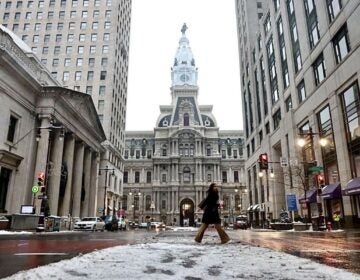Seared into city’s memory, MOVE tragedy holds lessons that still resonate
ListenIf you lived in or near Philadelphia in 1985, you probably remember where you were 30 years ago when authorities dropped a giant explosive on the home of a group of radical black activists called MOVE.
It sparked a fire that killed 11 members, including five children, destroyed 61 homes and devastated the West Philadelphia neighborhood.
There’s still debate over what happened and why, but many see the bombing as part of a decades-long tradition of violent policing practices aimed at African-Americans.
Life in the neighborhood
Andrea Walls grew up on the 6200 block of Spruce, two blocks from the MOVE house. She remembers having playing games like “tag and 1, 2, 3 Ringo, catch a girl, kiss a girl and Atlantic City baseball.”
Walls says that everyone, block by block, looked after each other.
“My neighborhood felt so safe, and it had nothing do with the police,” she said. “It had to do with the people on their porches in their housecoats, looking out.”
It was leaving her neighborhood that worried Walls, who says she felt that violent policing made many young people feel constrained to the turf that they knew.
“It wasn’t until you stepped out of your neighborhood that the police became troubling,” says Walls.
Gerald Renfrow grew up on the 6200 block of Osage Avenue and has lived there for most of his life. When MOVE set up in a house a few doors away, Renfrow says at first he was fine with his new neighbors — but not for long.
“MOVE started boarding up their windows and doors. They erected a stage where they could espouse their philosophy with loudspeakers, using profanity, all hours of the day and night,” Renfrow recalls.
Renfrow’s home burned in the 1985 fire, but it was rebuilt. He still lives on the same spot, and while he didn’t agree with everything the group stood for, he’s outraged about what happened.
“The city took the position that, ‘we’ll exterminate them.'”
The legacy of policing
Violent, overzealous policing of the black community had been a complaint across the city for decades. When Wilson Goode, the first black mayor of Philadelphia, took office in 1984, there were high hopes his office would usher in sweeping police reform. The MOVE confrontation dashed that optimism.
Donald Tibbs, a law professor at Drexel University, says that to understand what happened between authorities and MOVE, you need to look at the history of blacks being met with force when they challenged the white establishment — from slave revolts to the beating of civil rights protesters.
“What essentially happens is you see that the police have developed a framework for managing black self-determination. Which is any blackness that challenges the white mainstream way of life,” says Tibbs.
Throughout the 1970s, MOVE and police and fire crews clashed as the group defied legal efforts to regulate their “back to nature lifestyle.” When a police officer died in a siege of another home occupied by MOVE members, it stoked intense anger on both sides.
Three decades later, complaints about how city police interact with residents continue. A recent investigation by the U.S. Department of Justice recommended 91 changes to policies that govern the use of deadly force.
Philadelphia police spokesman Lt. John Stanford says that policing has evolved a lot over 30 years.
“You know we don’t want those days of MOVE returning,” he says. “We don’t want the community to feel how members of the community felt during that incident.”
The department is reviewing the DOJ’s recommended changes and revising officer training and policies on use of force, Stanford says.
Lessons to be learned
Poet Andrea Walls was 21 when the bombing happened. While it seems unthinkable now, she sees parallels between the tragedy and current events. She says the city can still learn from what went wrong back then.
“It’s happening again, every day, in the increments of what happens in Ferguson, what happens in Staten Island, what happens in Oakland,” she says.
Thirty years after one of the country’s most extreme incidents of police brutality, Philadelphia’s police force is still struggling to regain the trust of a large chunk of the public it’s sworn to serve.
WHYY is your source for fact-based, in-depth journalism and information. As a nonprofit organization, we rely on financial support from readers like you. Please give today.




